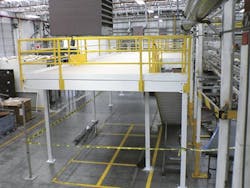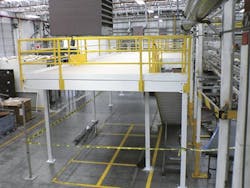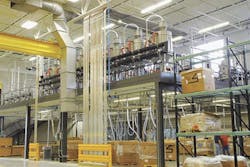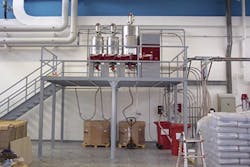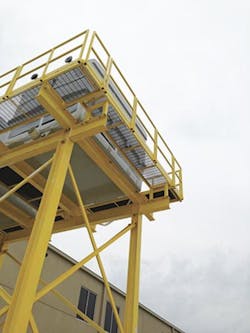Plant Design: Vertical spacing can optimize manufacturing
If business is looking up, it might be time to start building up.
Experts at plant design companies and OEMs say that mezzanines and tiers not only add floor space, they can create opportunities to optimize the manufacturing process. Thoughtful planning means keeping an eye on current business demands, while taking account of future needs.
Novatec's Kevin Embury cited several benefits for companies that invest in their vertical space, including "quick and easy material changeover, energy savings, labor savings, space savings," as well as the opportunity to move auxiliary equipment away from processing machines. The VP of engineered systems business development for Novatec, Embury said the company assists with 10 to 20 mezzanine projects a year — a huge rise over the one or two it took on when he first joined the auxiliary equipment maker in 2006.
Most greenfield plans now include mezzanines. Medical and automotive-parts molders, as well as sheet and film manufacturers, account for much of the interest in the structures, Embury said.
"Typically, you get more of a high-end user, someone who's going to be thinking futuristic, as they think about their systems," he said.
Benefits of Going Up
At its PET bottle-making facility in Wytheville, Va., Amcor Rigid Packaging opted to elevate. Besides freeing up floor space, the move has yielded numerous other efficiencies.
According to a case study prepared by Cubic Designs, a mezzanine supplier that worked with auxiliary equipment supplier Universal Dynamics, the project creates a rational layout. The design uses a workflow that incorporates multiple surge bins, granulators, gravimetric blenders, vacuum pumps and other materials-handling equipment.
With gravity tubes moving material to blenders and hoppers, there's no need for vacuum conveying. "At an estimated $1.50 an hour to run a 25-HP [horsepower] motor, this conveying step equates to a savings of about $40,000 a year for the six-unit mezzanine," the case study states.
Being able to store materials close to the machines where they'll be processed can save both time and money, according to auxiliary equipment suppliers.
"It helps you to manage the process flow. It keeps things clean. It keeps things neat," Embury said.
Embury cited another advantage, as well: resin prices. Buying in bulk saves money, and plans for mezzanines usually include silos. For customers who use a large variety of resins, such as medical molders, such an advantage can be persuasive. Compared to about six or eight years ago, Embury said the proportion of mezzanine customers who request silos has doubled, to about 70 or 80 percent, he said.
Making the Leap
When there's nowhere to go but up or out, mezzanines can provide a cost-effective option for adding space.
"To do a mezzanine system, it's usually much less [expensive] than to blow out walls and add onto the building," said Shannon Salchert, marketing manager for Cubic Designs. "There's very minimal disruption. We try to let people work as much as they can without shutting down production."
The built-to-order structures can be expanded easily, and can even be moved from one facility to another or reconfigured "like an erector set," Salchert said.
Mezzanine suppliers generally collaborate with equipment and machine suppliers to build the structures for plastics processors. In other cases, OEMs work directly with their clients on building projects and then contract with mezzanine suppliers to build the structures. Chad Kuchler, a regional sales manager with Steele Solutions, which works mainly with blown film companies, said towers with good looks get high marks.
"People are wanting — at least in the blown film industry — towers that highlight their equipment," Kuchler said. "They want a big, vibrant tower that kind of says to their customers — the people that are ultimately going to buy their product — 'Hey, look at this.'"
Aesthetics are important, but materials-handling functions, including conveying, are major factors in planning a multiple-tier layout. Safety and cost are also top of mind, Salchert said.
"Layout and material flow — receiving of materials to the shipping of final goods — are key considerations," said Linda Campbell, Entek Extruders' director of sales.
Other important considerations include the number of machines the plant intends to operate, the requirements of the material the plant uses, and how far it must travel from storage bins or silos to blenders, feeders and primary machines, said Steve Corcoran, national sales manager for Dri-Air Industries.
"You don't want to spend a lot of time and energy drying a resin, especially one that's hygroscopic, and then convey it a long distance," Corcoran said. Extended conveying time or distance, and excessive changes in direction, can damage resin and cause the development of angel hair. Blending accuracy can suffer, too.
Building vertically can help address such concerns.
"Resin material gaylords, or storage, dryer systems and blenders can be placed on mezzanines to use both upstairs and downstairs space more efficiently," Wittmann Battenfeld President David Preusse said.
For processes such as bottle making, Corcoran said that mezzanines create room for manufacturers to treat resin right at the machine, so it maintains its material properties.
"If you wanted to, you could even add a final dryer right at the throat of the machine, just to give that material a final kiss of drying," he said.
Embury noted other benefits as well. Piping can be removed from the floor, where it takes up space and can pose a tripping hazard. In addition, vacuum pumps that are placed off the floor tend to operate more quietly.
When Dri-Air equipment users are planning to build up, Corcoran said he usually begins by touring the space to get a feel for the plant's materials-handling requirements.
"It's very important to listen to a customer and find out what they're trying to achieve," he said.
Conair project manager Wes Diaz, who works materials-handling installations, said the company tries to help its customers determine the equipment that best suits their needs; through this process, they can nail down their space and utility requirements.
When planning a second tier, Diaz said companies should consider accessibility to resources such as equipment, maintenance areas and silos. "Assuring proper access means not only that you maintain appropriate clearances from overhead structures, but also personnel access for operations and maintenance."
Lofty Goals
A major limiting factor to adding a mezzanine is the roof. Brian Dowler, VP of aftermarket services for Conair, said the existing space in a plant can dictate the logistics of a vertical renovation.
Stacked machinery configurations, such as loaders on top of blenders over the machine throat, can create more floor space.
"For an existing facility with a low ceiling, it may be possible to open up the ceiling, drop in a tall piece of equipment, such as a large accumulator-head blow molding machine, and then build a 'doghouse' roof over the hole," Dowler said.
Designers and plant owners also need to remember to leave space for equipment such as overhead cranes.
Kuchler said processors with a just-right-sized plant might discover their roof's actually too low when they're awarded a new contract with specifications and demands that exceed what they've done in the past. It's a dilemma anyone contemplating a construction project should consider; even so, depending on local laws, new roofs can often be put onto a building to accommodate extra levels.
Laying Out the Logistics
With space ready for a mezzanine, the process of plotting out machinery locations is akin to a home renovation, Diaz said.
"Much like a kitchen designer always tries to maintain the kitchen triangle (the triangular path of movement between the refrigerator, sink and stove), our system designers are knowledgeable about the best locations for equipment based on plant production," he said.
With a mezzanine, much of the auxiliary equipment, including dryers, blenders and vacuum pumps, can be located above processing machines. Entek's Campbell said that companies also need to factor in the space requirements of forklift paths and safety rails, as well as code requirements.
Using central systems, which include everything from materials-storage units to surge bins, dryers, blenders and conveyors, processors enjoy the ability to integrate vertically, Novatec's Embury said. Having a second level provides the space.
Though the systems represent a significant investment, he said they also offer major advantages. These include quick and easy material changeovers, and energy and labor savings. Using central dryers, instead of one dryer for every press, plant operators can consolidate the need for filter changes and reduce maintenance requirements.
By bringing everything together, Dowler said companies can achieve greater efficiency and control.
"For example, centralizing resin handling and preconditioning in a single, compact area away from the processing machine, or in an elevated space such as a mezzanine, can make sense," Dowler said, citing Conair equipment. "Central systems like ResinWorks are easily served by resin-selection stations that can convey multiple materials from many sources to many destinations, all in a small footprint."
Dowler said some of Conair's materials-handling installations carry resins more than 200 feet up, and even greater heights are possible. "Using our Wave
Conveying technology, the material flows slowly and gently, eliminating abuse of the material that causes dust or angel hair."
The exact layout of equipment often is based on production requirements, said Diaz, Dowler's colleague. "Best practices include providing the shortest possible path for material conveyance, using centralized material storage when it's appropriate, and locating conditioning equipment so that output is as close to the machine throat as possible. For example, locating a drying hopper so that its discharge is close to the machine throat minimizes the potential for the material to experience moisture regain between the dryer and the processing machine."
To accommodate conveying requirements, Peter Lorenz, president of Lorenz Conveying, advises allowing access to hoses and switching valves. He pointed out that the "best practice is to keep piping, valves, switching stations, etc., near the silos and railcars to allow clean use of the central area of the floor."
Equipment needs
With multiple tiers come new maintenance and equipment needs. Some items, such as ladders or stairways, safety rails and kick plates, come as standard accessories.
Others, such as material lifts, scissor decks and forklifts, help access assets at greater heights.
Automated storage racking systems can contribute to the plant's overall efficiency, giving plant operators an easy way to manage their equipment. According to Preusse, "an elevator lift of shelves can store plant tools and spare parts, and they are stored in a PC by the station," allowing for easy lookups and retrieval.
A decision integral to the mezzanine itself is the type of decking that's used. A solid deck can better contain dust than regular metal grating, but users who opt for it also are required to install sprinklers, Embury said.
He also noted that because working on machines that are off the ground poses risks for employees, companies should invest in low-maintenance equipment. For
instance, Novatec provides vacuum receivers that have a blow-back function to keep material from collecting on their filters; with it, employees don't need to perform filter changes as frequently. In addition, the units feature hinges that automatically latch when opened, so employees don't have to use one hand to hold the lids up as they're working on them.
"We try to minimize the maintenance on these items that are tall and off the floor," he said.
Long-term planning
Whether building out or building up, companies should consider their future needs, advised the experts.
"If the question hasn't been asked of us, we should ask it of them, 'What do you think your next three to five years look like?' " Novatec's Embury said.
Dri-Air's Corcoran agreed. He recommended taking account of tomorrow's capacity needs today. "If we're going to build you a mezzanine, let's build it large enough so that you just pop in those extra machines and materials later," he said.
To do so, plant operators and owners should extend appropriate utilities to areas that they believe might serve as space for materials storage, heating or conveying in the future.
Entek's Campbell advised devising a plan that offers flexibility. "Power and water requirements, ceiling height, material conveying, etc., should be looked at for more than the immediate build," she said. "Some components in the plant, such as material handling and mezzanine space, can be shared among multiple lines."
Corcoran and others recommended that plant managers invest in conveyors, control panels and dryers that exceed their immediate needs. Lorenz advised they look for components they can grow into.
"Using automatic valves allows flexibility for growth and the components are modular, and the capacity can just be added," he said.
For Embury, one area of particular concern is drying. That's because of the proliferation of engineering resins. Central systems allow users to add capacity as needs change. "One of the good things about these central systems is if you plan right, you can plan for future growth."
Looking both up and out, companies can prepare for both current needs and future demands.
"Future expansion capability can and should be considered in any system design," Conair's Diaz said.
Karen Hanna, copy editor
For more information
Conair Group,Cranberry Township, Pa., 724-584-5500, www.conairgroup.com
Cubic Designs Inc.,New Berlin, Wis., 262-789-1966, www.cubicdesigns.com
Dri-Air Industries Inc.,East Windsor, Conn., 860-627-5110, www.dri-air.com
Entek Extruders,Lebanon, Ore., 541-259-1068, www.entek.com
Lorenz Conveying Products,Cobourg, Ontario, 905-372-2240, www.lorenz.ca
Novatec Inc.,Baltimore, 410-789-4811, www.novatec.com
Steele Solutions Inc.,Franklin, Wis., 414-367-5099, http://steelesolutions.com
Universal Dynamics Inc.,Woodbridge, Va., 703-490-7000, http://unadyn.piovan.com
Wittmann Battenfeld Inc.,Torrington, Conn., 860-496-9603, www.wittmann-group.com
About the Author
Karen Hanna
Senior Staff Reporter
Senior Staff Reporter Karen Hanna covers injection molding, molds and tooling, processors, workforce and other topics, and writes features including In Other Words and Problem Solved for Plastics Machinery & Manufacturing, Plastics Recycling and The Journal of Blow Molding. She has more than 15 years of experience in daily and magazine journalism.
